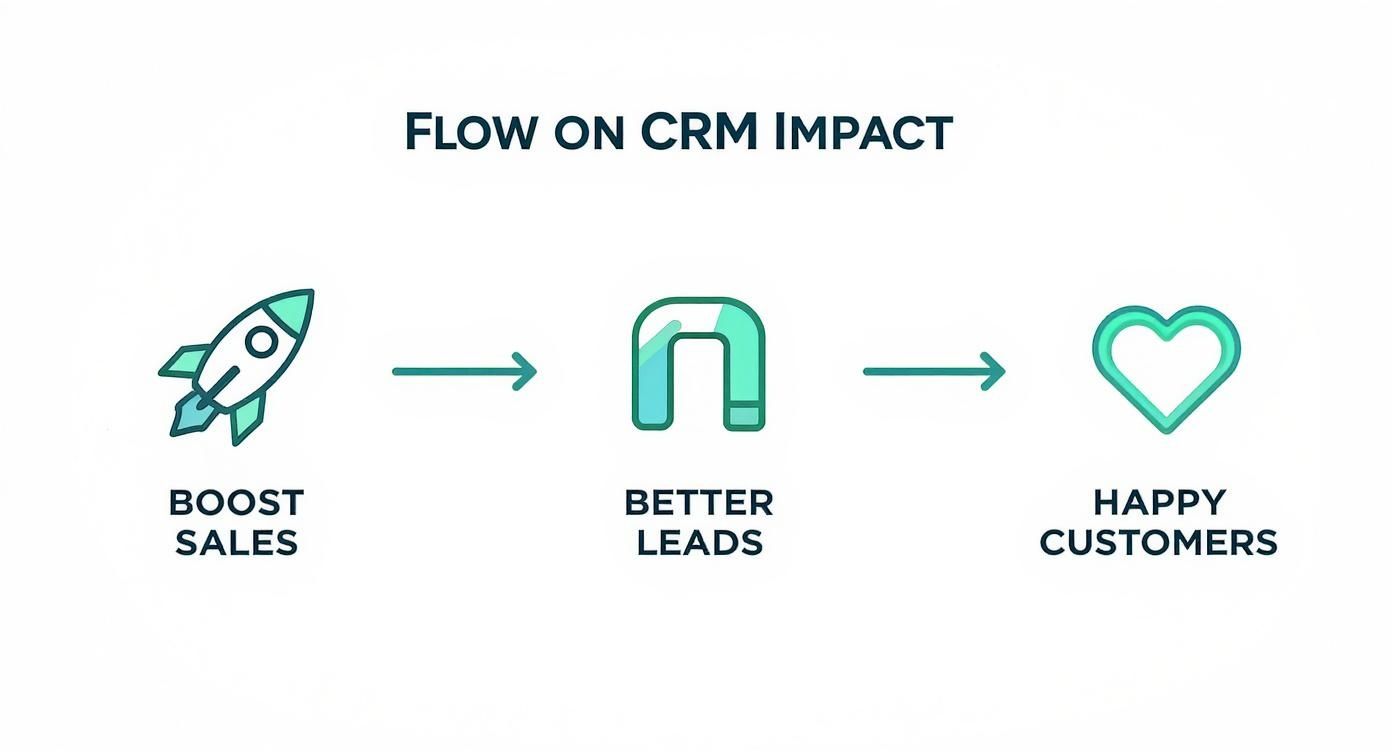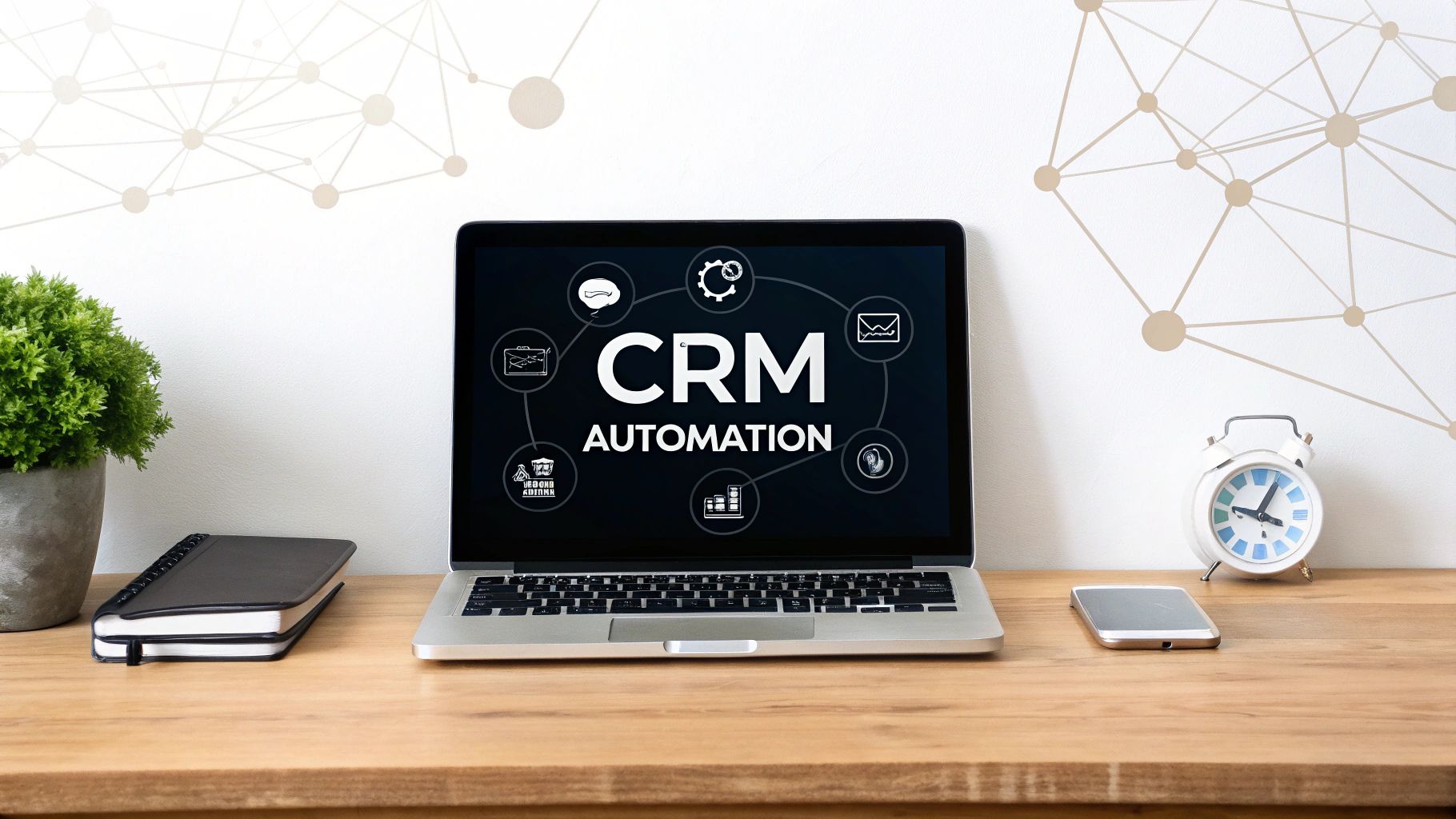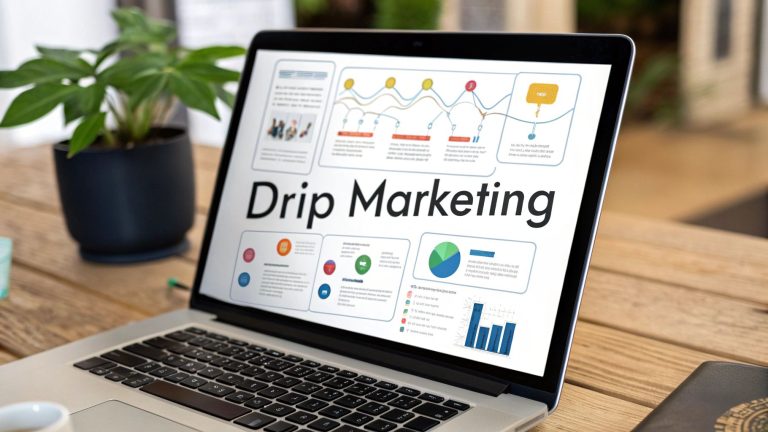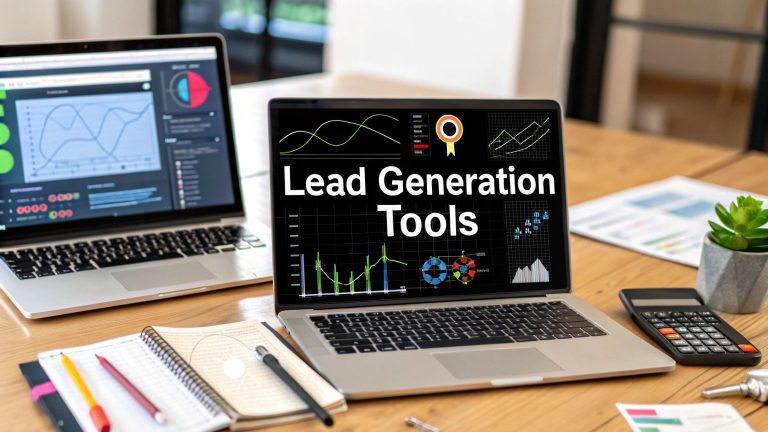what is crm automation: Boost Growth and Sales
So, what exactly is CRM automation?
Think of it as the ultimate assistant for your sales, marketing, and service teams—one that never sleeps, never forgets, and handles all the tedious, repetitive tasks that eat up your day. It’s about putting your customer relationship management on autopilot so your team can ditch the grunt work and focus on what they do best: building relationships and closing deals.
What Is CRM Automation in Simple Terms?
Let's get practical. Imagine a new lead fills out a form on your website.
Without automation, you'd have to manually copy-paste their info into your CRM, assign it to a sales rep, draft a welcome email, and then create a reminder to follow up in a few days. It's a clunky, multi-step process that's prone to errors and delays.
Now, picture it with automation. The moment that form is submitted, a pre-set workflow kicks in. The system instantly creates a new contact, assigns it to the right person, sends a personalized welcome email, and schedules a follow-up task. All of this happens in seconds, without a single click from you.
That’s the magic of CRM automation. It uses a trigger (like a new lead) to set off a chain of actions, ensuring every customer interaction is lightning-fast, consistent, and error-free.
This isn’t just a nice-to-have feature anymore; it’s a core part of how modern businesses operate. It's no surprise that over 90% of companies with more than 11 employees use a CRM, and a huge reason is the power of automation. In fact, 82% of businesses lean on CRM automation for sales reporting and process management alone, which is key to keeping the customer experience consistent.

Putting Your Customer Relationships on Autopilot
The "autopilot" analogy really hits home because it captures the essence of CRM automation. You're not micromanaging every interaction; you're building smart, self-operating workflows that guide the customer journey smoothly and efficiently. This improves your internal processes and the customer's experience. To see this in action, it's helpful to explore the features of a Follow Up CRM.
Some of the key functions of this autopilot system include:
- Automated Data Entry: No more manual typing. Contact info is captured and updated instantly.
- Smart Lead Routing: New leads get assigned to the right salesperson based on rules you create (like location or interest).
- Timed Follow-ups: Emails get sent or follow-up tasks get created for your team at the perfect moment.
By automating these foundational tasks, businesses don’t just save a ton of time. They build a more reliable and scalable process. It means no lead ever slips through the cracks and every customer feels like they're getting personal attention—which is absolutely vital for growth.
To help you see the bigger picture, here's a quick breakdown of what CRM automation does and the direct benefits you get from it.
CRM Automation at a Glance Key Functions and Benefits
| Automated Function | Primary Business Benefit | Example Task |
|---|---|---|
| Lead Nurturing | Warms up leads over time with relevant content. | Sending a sequence of educational emails after a lead downloads an eBook. |
| Data Entry & Updates | Ensures data is accurate and up-to-date without manual effort. | Automatically updating a contact's record when they open an email or click a link. |
| Sales Workflow Automation | Standardizes the sales process and moves deals forward. | Creating a follow-up task for a sales rep two days after a demo is completed. |
| Lead Scoring | Prioritizes hot leads so sales can focus on the best opportunities. | Adding points to a lead's score when they visit the pricing page. |
| Customer Service Tickets | Routes support requests to the right person for faster resolution. | Automatically creating and assigning a support ticket from an incoming customer email. |
| Reporting & Analytics | Provides real-time insights into team performance without spreadsheets. | Generating a weekly sales pipeline report and emailing it to managers. |
As you can see, each automated function directly translates to a tangible business outcome, whether it's faster follow-up, a more organized team, or better decision-making.
Ultimately, CRM automation is the glue that connects different parts of your business. For it to work, though, you need solid connections between your different tools. To get a better handle on how these systems talk to each other, you might want to check out our guide on what is CRM integration.
The Real-World Payoff of CRM Automation
It’s one thing to know what CRM automation is, but it's another thing entirely to see what it can do for your bottom line. For small and mid-sized businesses, this isn't just about saving a bit of time—it's about building a machine for growth.
By taking over the repetitive, soul-crushing tasks that eat up your team's day, automation gives them the freedom to focus on what actually moves the needle: building relationships and closing deals.
Think about it. When your sales reps aren't stuck manually entering lead data or trying to remember who to follow up with next, they can put all that energy into having real conversations. That human touch, backed by the speed of automation, is where you win customers for life.
Give Your Sales Productivity a Serious Jolt
One of the first things you'll notice with CRM automation is a massive jump in sales productivity. Manual tasks aren't just slow; they’re breeding grounds for mistakes and missed opportunities. Automation takes that entire mess off your team's plate.
Imagine a world with no more CSV downloads. No more copy-pasting lead details from one system to another. Automated workflows grab every new lead the second it comes in, log the details, and get it to the right person instantly. This simple change kills costly delays and makes sure no lead ever slips through the cracks. It frees your team up to do what they do best: sell.
By standardizing your sales process, automation builds a consistent, reliable system. Every lead gets the right follow-up at the right time—a non-negotiable for pushing deals through your pipeline faster and more predictably.
This efficiency pays off, literally. Companies that go all-in on CRM automation see an average ROI of 324% over three years, and many start seeing returns in the first 6–12 months. Quick wins, like less data entry and lightning-fast lead response times, build momentum for the big-picture benefits like skyrocketing conversion rates. You can dig into more of these powerful CRM statistics over at tech.co.
Better Data Means Smarter Decisions
Beyond just making things faster, CRM automation drastically improves the quality of your data. When customer info gets updated automatically based on their actions—like opening an email or checking out your pricing page—your records are always accurate and up-to-date.
Clean, reliable data is the bedrock of smart business decisions. With automated reports, you get a clear, live view of your sales pipeline, team performance, and customer engagement without wasting hours wrestling with spreadsheets. This lets you spot trends, fix bottlenecks, and make strategic calls with total confidence.
Ultimately, CRM automation is about giving your business the intelligence and efficiency it needs to scale. You're not just buying a tool; you're building a smarter foundation for growth.
How CRM Automation Actually Works
So, how does this whole CRM automation thing actually work? It’s not some complicated black box. Think of it like setting up a series of dominoes—you just need to know which pieces to put where to make something happen automatically.
At the heart of it all are three simple parts: Triggers, Conditions, and Actions. Once you get how these three work together, you can build just about any workflow you can dream up. This simple framework is what turns your static contact list into a living, breathing system that drives growth for you.
The Three Building Blocks of Automation
Every single automated workflow runs on a basic "if this, then that" logic. Nailing this concept is the first real step to becoming a pro with your CRM.
-
Triggers: This is the starting gun. A trigger is the specific event that kicks off your entire workflow. It’s the "if" part of the equation. A perfect example is a potential customer filling out a contact form on your website.
-
Conditions: These are the rules you set to make sure the automation goes down the right path. Conditions are like a traffic cop, directing the flow. For instance, a condition might check, "Is the lead's company bigger than 50 employees?"
-
Actions: This is the "then that" part—it's the actual task the system performs. An action is the job your automation does once a trigger fires and any conditions are met. This could be anything from sending a welcome email to assigning the new lead to your top salesperson.
This logical flow of Trigger -> Condition -> Action is the engine that powers every piece of CRM automation.
The real magic isn't in one single action. It's in stringing them together to create a complete customer journey. A single trigger can kick off a whole chain of events that takes a lead from just browsing to being ready for a sales call—all without you lifting a finger.
Visualizing a Simple Workflow
Let's see how these blocks fit together with a super common example: a new lead from your "Contact Us" form.
- Trigger: A visitor hits 'submit' on your "Contact Us" form.
- Condition: The form field "Industry" is "Manufacturing."
- Action 1: The system instantly tags the new contact as a "Manufacturing Lead."
- Action 2: The lead gets assigned to the sales rep who handles your manufacturing accounts.
- Action 3: An automated, personalized email goes out from that rep, mentioning their expertise in the manufacturing space.
This whole thing happens in seconds. The right lead gets to the right person with the right message, immediately. From here, you could build out different paths for other industries or company sizes. If you want to go deeper, our guide on what is an automated workflow breaks this down with even more examples.
The infographic below shows how these little automated processes add up to big wins—boosting sales, getting you better leads, and keeping your customers happy.

It’s a clear picture of how putting automation in place directly leads to hitting your business goals. Every small workflow you build becomes a part of a much bigger strategy for growth.
CRM Automation Examples in the Real World
Theory is great, but seeing CRM automation in action is where the lightbulb really goes on. Let's ditch the definitions for a minute and look at some real-world situations where automation turns clunky, manual work into smooth, efficient workflows that actually get results.
One of the most common and powerful examples for marketers today is handling leads from social media ads, like Facebook Lead Ads.
From Manual CSV Hell to Instant Lead Sync
Without automation, the process is a nightmare. A potential customer sees your ad on Facebook, fills out the form, and… crickets. Hours, maybe even a whole day, go by before a marketer logs into Facebook Ads Manager, downloads a CSV file, cleans up the data, and finally uploads it into the CRM.
By the time that lead actually gets to a sales rep, the prospect’s initial excitement is long gone. That delay is a deal-killer, plain and simple.
Now, let's see how it works with automation:
- The Instant Connection: The second a user hits "submit" on a Facebook Lead Ad, a tool like LeadSavvy Pro grabs that data instantly.
- Automated Routing: That lead is automatically zapped over to wherever you need it—a Google Sheet for tracking, straight into your CRM, or both.
- Immediate Notification: Your sales team gets an email notification right away with all the new lead's details.
This automated flow transforms lead response time from hours into seconds, massively boosting your odds of making a real connection.
This screenshot shows just how simple it is to set up this bridge between your ad platform and your sales team.
The magic here is in eliminating all those manual steps. It's not just about saving time; it's about ensuring your data is accurate and, most importantly, fast.
Other Powerful Automation Use Cases
Beyond just capturing leads, CRM automation is a game-changer in a ton of other areas. It's become a cornerstone for modern businesses, helping teams reclaim an average of 5–10 hours per week by putting repetitive tasks on autopilot.
Here are a few more high-impact examples:
1. Automated Customer Onboarding
The moment a new customer signs up, a workflow can kick off a welcome email series. This sequence can introduce them to your product, point them to helpful guides, and even schedule a check-in call. It's all about creating a smooth, positive start to their journey with you. For a deep dive into this, check out this real-world marketing automation example.
2. Smart Task Creation for Support Teams
Imagine a customer submits a support ticket with keywords like "urgent" or "billing issue." Automation can instantly flag it as high-priority, create a task, and assign it to the right person. This ensures your most critical issues get handled immediately, without falling through the cracks.
These real-world applications show that CRM automation isn’t just about sending emails. It's about creating intelligent, responsive systems that enhance every stage of the customer lifecycle, from the first touchpoint to long-term support.
Even small efficiencies in communication add up. For example, mastering something like automated email scheduling in Outlook can give your sales and marketing follow-up a serious boost.
Building Your First Automation Workflow

Jumping into CRM automation can feel like you’re about to climb a mountain, but it doesn't have to be that hard. The secret is to start small. Nail one simple, high-impact process that gives you an immediate win.
Forget trying to automate your entire sales funnel on day one. Instead, pick one repetitive task that’s currently draining your team's time and energy.
A perfect place to begin is with the initial follow-up for new leads. This is your first handshake, your first impression, and it's absolutely critical. It’s also where delays and human error love to sneak in. By automating it, you solve a real-world problem and see the results almost instantly.
Find a Simple, High-Impact Process
Before you touch any software, you need to find the right candidate for automation. What are you looking for? A task that is repetitive, rule-based, and time-sensitive. A "New Lead Welcome Email" is the poster child for a great first workflow.
Why this one? Because the logic is dead simple: when a new lead comes in, we send them a welcome message. Right away. The impact is huge because a fast response can dramatically boost your odds of turning that lead into a customer.
Define Your Trigger, Conditions, and Actions
Once you've picked your process, it's time to map it out. Every automation is built on three core parts. Using our new lead example, it would look something like this:
- Trigger: A new contact is created from a specific source, like your "Request a Demo" web form. This is the starting gun.
- Condition (Optional): You could add a filter here, like, "Only run this workflow if the lead came from 'Facebook Ads'." For your first time, it's best to keep it simple and skip this.
- Action: The system automatically sends a pre-written welcome email to the new contact. This is the "then that" part of the equation.
This straightforward "if this, then that" setup is the foundation of your first win with automation. It guarantees every new lead gets a consistent and immediate welcome, setting a professional tone from the get-go.
Building your first workflow isn’t really a tech challenge—it’s a thinking challenge. When you break a process down into its core parts (trigger and action), you demystify the whole concept of automation. This builds the confidence you need to tackle more advanced stuff later.
Best Practices for Your First Workflow
As you take these first steps, keep a few key ideas in mind. They’ll help you launch smoothly and avoid the common headaches. Think of these less as tips and more as solid habits for effective CRM automation.
-
Start Small and Simple: Fight the urge to build a complex, ten-step masterpiece. A single action, like sending one email, is perfect. You can always add more bells and whistles later after you know the basic engine is running.
-
Test, Test, and Test Again: Before you let your new workflow loose on real leads, test it with an internal email address. Fill out the form yourself. Did the trigger fire? Did the email arrive? Check for typos, make sure the links work, and confirm any personalization tags (like
{{first_name}}) are pulling in the right info. -
Ensure Your Data Is Clean: Automation is only as good as the data it’s working with. Garbage in, garbage out. Make sure your forms are capturing the right information cleanly. Bad data leads to broken workflows and a terrible customer experience.
Common CRM Automation Mistakes to Avoid
Jumping into CRM automation is a game-changer, but knowing what not to do is just as critical as knowing what to do. A few common missteps can quickly turn a brilliant time-saver into a source of pure frustration, damaging your internal workflow and even your customer relationships.
Think of it this way: steering clear of these pitfalls is how you make sure your automation efforts actually deliver the goods from day one. It’s about being smart and strategic, not just flipping an "on" switch.
Over-Automating and Losing the Human Touch
This is the big one. The most common mistake is getting so excited about efficiency that you automate everything. While the goal is to be faster, stripping away all human interaction makes your brand feel cold, robotic, and impersonal. Trust me, customers can sniff out a machine-only experience from a mile away, and it's a huge turn-off—especially for those bigger deals that need a real conversation to close.
A good rule of thumb is to automate the process, not the relationship. Use automation for the grunt work like data entry, sending the first quick follow-up, or scheduling calls. But always, always leave room for a real person to jump in and add that critical human touch.
Automation should free up your team to have more meaningful conversations, not get rid of them completely. The best setups blend robotic speed with genuine human connection, creating an experience that feels seamless to the customer.
Building Workflows on Bad Data
Another killer mistake is building out beautiful, complex workflows on a foundation of messy, inaccurate data. Automation is incredibly literal. If you feed it bad info, it will execute flawed actions perfectly, every single time. This is the classic "garbage in, garbage out" problem, and it's a fast way to look unprofessional.
Think about it: an automated email campaign that uses the wrong first name or references an old job title doesn't just fail to convert—it actively damages your credibility.
- Audit Your Data: Get in the habit of regularly cleaning your contact lists. Hunt down duplicates, fix typos, and get rid of outdated info.
- Standardize Your Forms: Use dropdowns and required fields on your lead forms. This forces data to be captured in a consistent, clean format from the start.
- Check Your Syncs: Make sure the tools you've connected (like Facebook Lead Ads and your CRM) are talking to each other correctly to avoid weird data mismatches.
Failing to Monitor and Optimize
Finally, so many businesses make the mistake of "setting and forgetting" their automation. This isn't a crockpot. You can't just throw everything in and walk away, hoping for the best. Your workflows need ongoing attention to make sure they’re actually working and getting you the results you want.
Without a watchful eye, a broken workflow could go unnoticed for weeks, silently tanking your lead follow-up and costing you real money. Make it a habit to regularly review your automation analytics. Are people opening your emails? Are tasks getting completed on time? Use that data to tweak, refine, and improve your workflows over time so they grow right alongside your business.
Got Questions About CRM Automation?
Even after you get the hang of what CRM automation is all about, a few practical questions always seem to pop up. Let's clear the air on some of the most common ones so you can see how this stuff really works in the wild and feel good about moving forward.
Is CRM Automation Just for the Big Guys?
Not a chance. While huge companies definitely get a lot out of it, you could argue CRM automation is an even bigger deal for small and mid-sized businesses (SMBs). When you're running a leaner team and watching every dollar, efficiency isn't just a buzzword—it's what keeps the lights on.
Automation is the great equalizer. It gives smaller companies the power to deliver the kind of polished, consistent follow-up that used to be reserved for corporations with massive sales departments. It makes sure no lead ever slips through the cracks and frees up your people to do the high-impact work, letting you punch well above your weight.
Is This Going to Replace My Sales Team?
Nope. Think of CRM automation as a super-powered assistant for your sales team, not a replacement. Its job is to handle all the repetitive, thankless tasks that salespeople secretly (or not-so-secretly) hate—things like manual data entry, sending the first "hello" email, or scheduling follow-up reminders.
This frees up your team to focus on what people do best: building real relationships, digging into complex customer problems, and closing deals. It turns them from data-entry clerks into strategic sellers.
How Much of a Tech Whiz Do I Need to Be?
Honestly, not as much as you might think. While the tech skills needed can vary, most modern platforms are built for regular business folks, not coders. You'll find that many systems use visual, drag-and-drop editors that let you build some seriously powerful workflows without touching a single line of code.
For a simple automation—like sending a welcome email to a new subscriber—you won't need any technical skills at all. Sure, more complex setups that tie multiple tools together might require a bit more know-how, but for the most part, you can get started in just a few minutes.
Ready to stop wasting time on manual downloads and start converting leads faster? LeadSavvy Pro instantly connects your Facebook Lead Ads to your CRM or Google Sheets, sending you real-time notifications. Start for free and automate your lead flow today.







